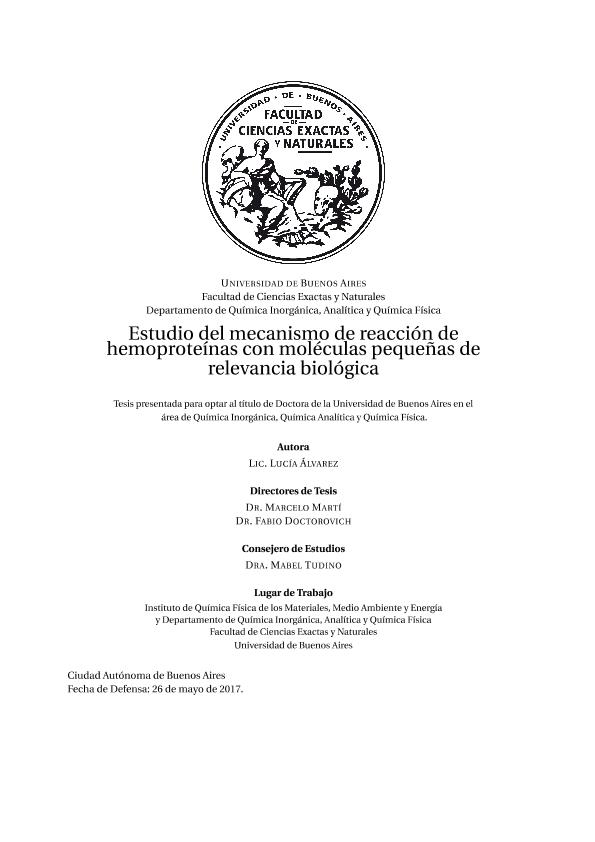Tesis doctoral
Las hemoproteínas son un conjunto ubicuo y extenso de proteínas, con una enorme diversidadfuncional relacionada con la versátil reactividad del ion de hierro del grupo hemo. La gran mayoría desus funciones biológicas involucran la unión de ligandos pequeños al metal, regulada por la identidad ydinámica de los aminoácidos de su entorno. La presente tesis tiene como objetivo aportar informaciónmicroscópica acerca de los mecanismos de reacción de distintas hemoproteínas con moléculaspequeñas de relevancia biológica, como ser O2, H2 O2, NH2OH e hidropersulfuros, utilizando unacombinación de técnicas de simulación computacional y experimentales, que incluyen, por unlado, dinámica molecular clásica (que abarca técnicas de muestreo demúltiples réplicas) e híbridascuántico-clásicas (para el estudio de fenómenos reactivos), y por otro espectroscopía UV-visible,cinética de reacción utilizando un equipo flujo detenido y un electrodo sensible a HNO, recientementedesarrollado por el grupo donde fue realizada la presente tesis, para el seguimiento de su producción.En primer lugar fue estudiada ?por técnicas de simulación?la unión de sustrato y el mecanismode reacción de dos dioxigenasas hémicas, la indolamino 2,3-dioxigenasa y triptófano 2,3-dioxigenasa,mostrando cómo la dinámica de un loop flexible modula la actividad enzimática al regular la entrada/salida de sustrato. En segundo lugar, se estudió la producción de HNO debido a la peroxidación dehidroxilamina catalizada por mioglobina. Se utilizaron técnicas experimentales para caracterizar la cinética de reacción, y luego se analizó el mecanismo de reacción a través de métodos computacionales.Por último, se estudió experimentalmente la reacción de hidropersulfuros con mioglobina,mostrandola capacidad de los mismos de regular la reactividad del grupo hemo. The hemeproteins comprise a large group of ubiquitous proteins with a great functional diversity related to the versatile reactivity of the iron atom in the heme group. Most of their biological functions involve small ligands binding to the metal atom, regulated by the identity and the dynamics of the aminoacids present in the active site. The main goal of this work is to give microscopic information about the mechanism of reaction of different heme proteins with small molecules of biological relevance such as O2, H2 O2, NH2OH, and hydropersulfides. The employed methodologies consist of both computer simulations and experimental techniques. On one hand classical molecular dynamics simulations were performed, in order to characterize flexible loop dynamics together with hybrid quantum mechanics-molecular mechanics (QM-MM) simulations that allow the analysis of reactive processes inside the protein matrix. On the other hand, experimental methods such as UV-vis were used to characterize the reaction products, and stopped-flow UV-Vis spectrophotometry to describe the reaction kinetics along with an HNO electrode to measure the HNO generation. Firstly, we studied, using computational techniques, the substrate binding and the reaction mechanism of two hemedioxygenases, tryptophan dioxygenase (TDO) and indoleamine 2,3 dioxygenase (IDO), showing how a flexible loop modulates the enzymatic activity of the protein by regulating the substrate and product entrance. Secondly, we studied the peroxidation activity of hydroxylamine catalyzed by myoglobin producing HNO. This was studied combining both experimental and computational techniques. Finally, we studied the reaction of hydropersulfides with myoglobin showing the capacity of regulation of the heme proteins by this type of compound.
Estudio del mecanismo de reacción de hemoproteínas con moléculas pequeñas de relevancia biológica
Título:
Study of the reaction mechanism of heme proteins with small molecules with biological relevance
Álvarez, Lucía

Director:
Marti, Marcelo Adrian

Codirector:
Doctorovich, Fabio

Consejero de estudios:
Tudino, Mabel Beatriz

Fecha de publicación:
01/01/2017
Idioma:
Español
Clasificación temática:
Resumen
Palabras clave:
Hemoproteínas
,
Mecanismo
,
Reactividad
,
Oxígeno
,
Hidropersulfuros
,
Hno
Archivos asociados
Licencia
Identificadores
Colecciones
Tesis(INQUIMAE)
Tesis de INST.D/QUIM FIS D/L MATERIALES MEDIOAMB Y ENERGIA
Tesis de INST.D/QUIM FIS D/L MATERIALES MEDIOAMB Y ENERGIA
Citación
Álvarez, Lucía; Marti, Marcelo Adrian; Doctorovich, Fabio; Tudino, Mabel Beatriz; Estudio del mecanismo de reacción de hemoproteínas con moléculas pequeñas de relevancia biológica; 1-1-2017
Compartir



